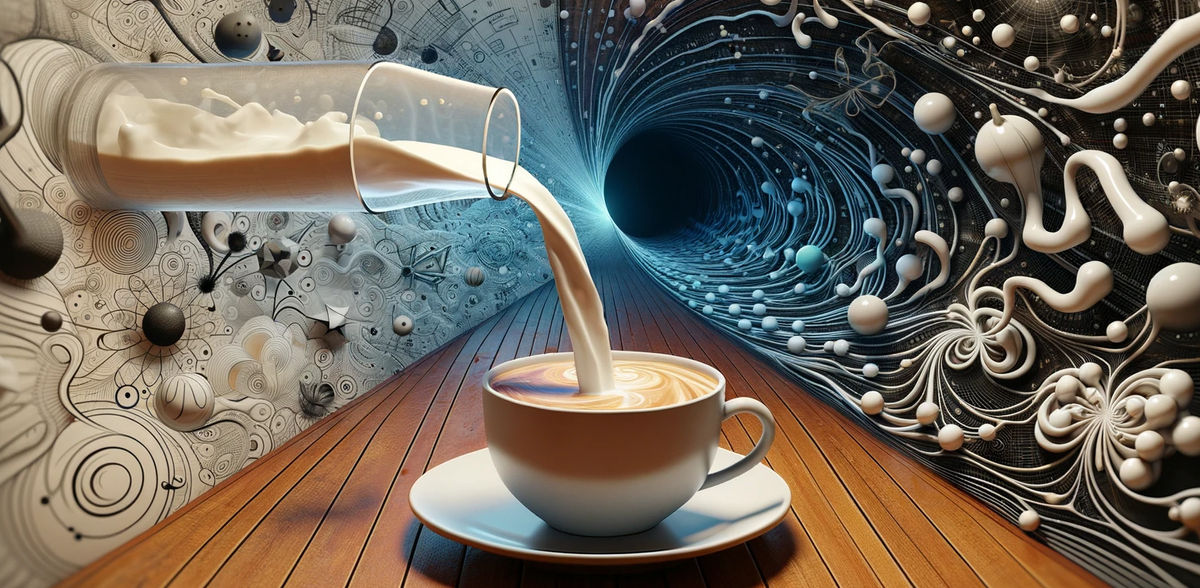What coffee with cream can teach us about quantum physics
Advertisement
Add a dash of creamer to your morning coffee, and clouds of white liquid will swirl around your cup. But give it a few seconds, and those swirls will disappear, leaving you with an ordinary mug of brown liquid.
Something similar happens in quantum computer chips—devices that tap into the strange properties of the universe at its smallest scales—where information can quickly jumble up, limiting the memory capabilities of these tools.
That doesn’t have to be the case, said Rahul Nandkishore, associate professor of physics at the University of Colorado Boulder.
In a new coup for theoretical physics, he and his colleagues have used math to show that scientists could create, essentially, a scenario where the milk and coffee never mix—no matter how hard you stir them.
The group’s findings may lead to new advances in quantum computer chips, potentially providing engineers with new ways to store information in incredibly tiny objects.
“Think of the initial swirling patterns that appear when you add cream to your morning coffee,” said Nandkishore, senior author of the new study. “Imagine if these patterns continued to swirl and dance no matter how long you watched.”
Researchers still need to run experiments in the lab to make sure that these never-ending swirls really are possible. But the group’s results are a major step forward for physicists seeking to create materials that remain out of balance, or equilibrium, for long periods of time—a pursuit known as “ergodicity breaking.”
The team’s findings appeared this week in the latest issue of “Physical Review Letters.”
Quantum memory
The study, which includes co-authors David Stephen and Oliver Hart, postdoctoal researchers in physics at CU Boulder, hinges on a common problem in quantum computing.
Normal computers run on “bits,” which take the form of zeros or ones. Nandkishore explained that quantum computers, in contrast, employ “qubits,” which can exist as zero, one or, through the strangeness of quantum physics, zero and one at the same time. Engineers have made qubits out of a wide range of things, including individual atoms trapped by lasers or tiny devices called superconductors.
But just like that cup of coffee, qubits can become easily mixed up. If you flip, for example, all of your qubits to one, they’ll eventually flip back and forth until the entire chip becomes a disorganized mess.
In the new research, Nandkishore and his colleagues may have figured a way around that tendency toward mixing. The group calculated that if scientists arrange qubits into particular patterns, these assemblages will retain their information—even if you disturb them using a magnetic field or a similar disruption. That could, the physicist said, allow engineers to build devices with a kind of quantum memory.
“This could be a way of storing information,” he said. “You would write information into these patterns, and the information couldn’t be degraded.”
Tapping into geometry
In the study, the researchers used mathematical modeling tools to envision an array of hundreds to thousands of qubits arranged in a checkerboard-like pattern.
The trick, they discovered, was to stuff the qubits into a tight spot. If qubits get close enough together, Nadkishore explained, they can influence the behavior of their neighbors, almost like a crowd of people trying to squeeze themselves into a telephone booth. Some of those people might be standing upright or on their heads, but they can’t flip the other way without pushing on everyone else.
The researchers calculated that if they arranged these patterns in just the right way, those patterns might flow around a quantum computer chip and never degrade—much like those clouds of cream swirling forever in your coffee.
“The wonderful thing about this study is that we discovered that we could understand this fundamental phenomenon through what is almost simple geometry,” Nandkishore said.
The team’s findings could influence a lot more than just quantum computers.
Nandkishore explained that almost everything in the universe, from cups of coffee to vast oceans, tends to move toward what scientists call “thermal equilibrium.” If you drop an ice cube into your mug, for example, heat from your coffee will melt the ice, eventually forming a liquid with a uniform temperature.
His new findings, however, join a growing body of research that suggests that some small organizations of matter can resist that equilibrium—seemingly breaking some of the most immutable laws of the universe.
“We’re not going to have to redo our math for ice and water,” Nandkishore said. “The field of mathematics that we call statistical physics is incredibly successful for describing things we encounter in everyday life. But there are settings where maybe it doesn’t apply.”



























































